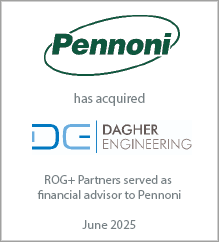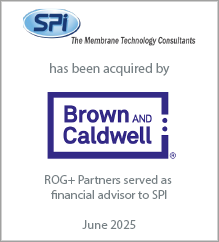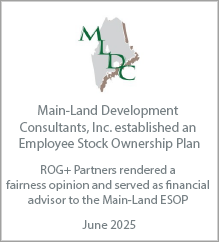Ian has spent the past twenty years working with hundreds of architecture, engineering and environmental consulting firms large and small throughout the U.S. and abroad with a focus on ownership planning, business valuation, ESOP advisory services, mergers & acquisitions, and strategic planning. Ian is a professionally trained and accredited business appraiser and holds the Accredited Senior Appraiser (ASA) designation with the American Society of Appraisers and is a certified merger & acquisition advisor (CM&AA) with the Alliance of Merger & Acquisition Advisors.
ESOPs – Often Lauded, Sometimes Maligned, Usually Misunderstood
October 19, 2016
As business owners in the A/E and environmental consulting industries examine their ownership transition options, we’re finding more and more are considering employee stock ownership plans (“ESOPs”). But too often, people have pre-conceived notions about ESOPs that are based on one or two anecdotal experiences. Perhaps they worked at a firm in the past that had an ESOP. Or maybe they have a professional colleague that instituted an ESOP in his or her firm. The problem is that ESOPs come in all shapes and sizes. An ESOP strategy that might have been successful for one company, may not be appropriate for another. Conversely, because a particular company had a disastrous experience with an ESOP, doesn’t mean that an ESOP couldn’t work for your firm.
General ESOP statistics
Here are some ESOP statistics that many readers may find surprising. The National Center for Employee Ownership (NCEO.org) reports that there are approximately 7,000 ESOP companies in the U.S., with the most common industries being manufacturing, banking, construction and, you guessed it, engineering. In fact, NCEO’s 2016 list of the top 100 ESOP companies include some of the country’s most prominent A/E firms, such as Gensler, HDR, Black & Veatch, Burns & McDonnell, HNTB, Terracon, Kleinfelder, and STV Group, among others.
However, ESOPs are not solely the province of large firms—on the contrary. NCEO’s latest study reports that 41% of ESOP-sponsoring companies have 50 or fewer employee-participants, and 60% have 100 or fewer employee-participants. So if you had dismissed an ESOP as an ownership transition alternative for your firm because you thought you were too small, you may want to reconsider.
Various Shapes and Sizes
One of the most common misconceptions is that all ESOPs must take the form of a leveraged transaction (i.e. the Company takes on debt to fund the ESOP’s purchase of stock from a retiring shareholder), or that the ESOP will end up as the controlling shareholder. In fact, ESOPs may be funded and accumulate stock in a number of ways, and the plan may hold ownership stakes ranging from a small minority interest up to 100%.
Many of the horror stories about failed ESOP companies involved highly leveraged transactions, where companies took on more debt than they could afford, or conducted a leveraged ESOP transaction and then experienced an unexpected downturn in their business. This is a legitimate concern in cyclical industries, or for businesses that have volatile earnings histories, but there are ways to address this.
An increasingly popular ESOP structure in the A/E industry is the non-leveraged or “pre-funded” plan. As an example, let’s say a firm is planning for the retirement of a group of shareholders anticipated to take place three years from now. The firm could establish an ESOP, and begin making cash contributions to the plan, effectively building a fund using pre-tax profits (contributions to an ESOP are a tax-deductible expense) that may be used at a future date to purchase stock from the retirees.
The advantage to the pre-funded plan is its flexibility. If the sponsoring company has a particularly strong year, it could increase its contribution to the plan (within statutory limitations), thereby sheltering more profit from taxation and potentially accelerating the timeline of the transition. And if the company had a weak year, it could reduce or postpone its contribution to the plan.
Controlling the process
The tax benefits that ESOPs provide to the sponsoring company, and in some cases to the sellers, are often what accounting and financial advisors focus on. However, while the tax savings of the ESOP structure can be significant, another advantage is often overlooked. Unlike orchestrating a sale to a select group of employee-managers, or seeking to sell to or merge with another firm, transitioning ownership to an ESOP is a process that can be planned and executed with a much higher degree of predictability.
With a sale to an ESOP, the company’s directors decide when and how to structure the transaction, and the share price is informed by an independent appraiser engaged by the ESOP’s appointed trustee to ensure that the ESOP does not pay more than fair market value for the stock in order to comply with the Employee Retirement Income Security Act (ERISA).
The afterlife
Once an ESOP has been established, its ownership level can be actively managed in accordance with the culture and strategic objectives of the Company. Our own A/E Ownership Transition Study, conducted in partnership with Practice Lab, indicates that the average ESOP ownership interest in the industry is 51%, and ranges from a low of 8% to a high of 100%. Many firms in the A/E industry maintain their ESOPs at a level that provides a meaningful employee account balance, while also allowing direct ownership opportunities for the management team.
The ESOP’s ownership level can be managed by controlling how repurchases of ESOP shares are handled (are the shares redeemed and cancelled, or recirculated to remaining plan participants), what is contributed to the plan, and the ESOP’s purchases of stock from retiring shareholders and the treasury.
The bottom line
When it comes to ownership transition planning, ESOPs are not the panacea. But if such an ownership model is in keeping with the culture and strategic direction of your firm, they may very well be an option worth considering.
***
Ian Rusk will be co-presenting an informative session on ESOPs together with Attorney David Solomon of Levenfeld Pearlstein, and Pete Prodoehl of Principal Financial Group on November 4th at the Growth & Ownership Strategies Conference in Naples, Florida. Registration for this popular educational and networking event is still open. Visit http://conference.rog-partners.com/ to register.
General ESOP statistics
Here are some ESOP statistics that many readers may find surprising. The National Center for Employee Ownership (NCEO.org) reports that there are approximately 7,000 ESOP companies in the U.S., with the most common industries being manufacturing, banking, construction and, you guessed it, engineering. In fact, NCEO’s 2016 list of the top 100 ESOP companies include some of the country’s most prominent A/E firms, such as Gensler, HDR, Black & Veatch, Burns & McDonnell, HNTB, Terracon, Kleinfelder, and STV Group, among others.
However, ESOPs are not solely the province of large firms—on the contrary. NCEO’s latest study reports that 41% of ESOP-sponsoring companies have 50 or fewer employee-participants, and 60% have 100 or fewer employee-participants. So if you had dismissed an ESOP as an ownership transition alternative for your firm because you thought you were too small, you may want to reconsider.
Various Shapes and Sizes
One of the most common misconceptions is that all ESOPs must take the form of a leveraged transaction (i.e. the Company takes on debt to fund the ESOP’s purchase of stock from a retiring shareholder), or that the ESOP will end up as the controlling shareholder. In fact, ESOPs may be funded and accumulate stock in a number of ways, and the plan may hold ownership stakes ranging from a small minority interest up to 100%.
Many of the horror stories about failed ESOP companies involved highly leveraged transactions, where companies took on more debt than they could afford, or conducted a leveraged ESOP transaction and then experienced an unexpected downturn in their business. This is a legitimate concern in cyclical industries, or for businesses that have volatile earnings histories, but there are ways to address this.
An increasingly popular ESOP structure in the A/E industry is the non-leveraged or “pre-funded” plan. As an example, let’s say a firm is planning for the retirement of a group of shareholders anticipated to take place three years from now. The firm could establish an ESOP, and begin making cash contributions to the plan, effectively building a fund using pre-tax profits (contributions to an ESOP are a tax-deductible expense) that may be used at a future date to purchase stock from the retirees.
The advantage to the pre-funded plan is its flexibility. If the sponsoring company has a particularly strong year, it could increase its contribution to the plan (within statutory limitations), thereby sheltering more profit from taxation and potentially accelerating the timeline of the transition. And if the company had a weak year, it could reduce or postpone its contribution to the plan.
Controlling the process
The tax benefits that ESOPs provide to the sponsoring company, and in some cases to the sellers, are often what accounting and financial advisors focus on. However, while the tax savings of the ESOP structure can be significant, another advantage is often overlooked. Unlike orchestrating a sale to a select group of employee-managers, or seeking to sell to or merge with another firm, transitioning ownership to an ESOP is a process that can be planned and executed with a much higher degree of predictability.
With a sale to an ESOP, the company’s directors decide when and how to structure the transaction, and the share price is informed by an independent appraiser engaged by the ESOP’s appointed trustee to ensure that the ESOP does not pay more than fair market value for the stock in order to comply with the Employee Retirement Income Security Act (ERISA).
The afterlife
Once an ESOP has been established, its ownership level can be actively managed in accordance with the culture and strategic objectives of the Company. Our own A/E Ownership Transition Study, conducted in partnership with Practice Lab, indicates that the average ESOP ownership interest in the industry is 51%, and ranges from a low of 8% to a high of 100%. Many firms in the A/E industry maintain their ESOPs at a level that provides a meaningful employee account balance, while also allowing direct ownership opportunities for the management team.
The ESOP’s ownership level can be managed by controlling how repurchases of ESOP shares are handled (are the shares redeemed and cancelled, or recirculated to remaining plan participants), what is contributed to the plan, and the ESOP’s purchases of stock from retiring shareholders and the treasury.
The bottom line
When it comes to ownership transition planning, ESOPs are not the panacea. But if such an ownership model is in keeping with the culture and strategic direction of your firm, they may very well be an option worth considering.
***
Ian Rusk will be co-presenting an informative session on ESOPs together with Attorney David Solomon of Levenfeld Pearlstein, and Pete Prodoehl of Principal Financial Group on November 4th at the Growth & Ownership Strategies Conference in Naples, Florida. Registration for this popular educational and networking event is still open. Visit http://conference.rog-partners.com/ to register.








